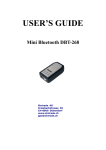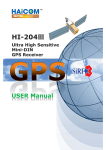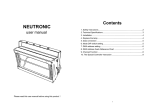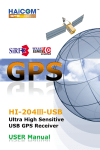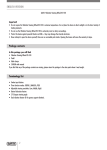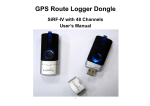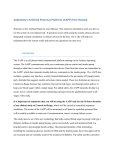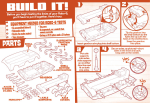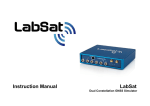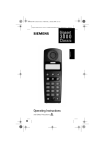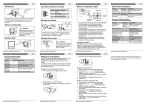Download Untitled - Sintrade AG
Transcript
HI-203E GPS Receiver 1 General description of what GPS is and how it works. GPS (Global Positioning System) is the only system today able to show you your exact position on the Earth anytime, in any weather, anywhere. GPS satellites, 24 in all, orbit at 11,000 nautical miles above the Earth. They are continuously monitored by ground stations located worldwide. The satellites transmit signals that can be detected by anyone with a GPS receiver. Using the receiver, you can determine your location with great precision. The satellites are positioned so that we can receive signals from six of them nearly 100 percent of the time at any point on Earth. You need that many signals to get the best position information. Satellites are equipped with very precise clocks that keep accurate time to within three nanoseconds- that's 0.000000003, or three billionths of a second. This precision timing is important because the receiver must determine exactly how long it take s for signals to travel from each GPS satellite. The receiver uses this information to calculate its position. Although GPS was designed for military use, many thousands of civi lians make use of it. The satellites actually broadcast two signals, one is only formilitary use, and one can be used by both military and civilians. Since GPS is passive (you only need to receive the signal), there are no restrictions on who can use the signal available to civilians. GPS technology can be used in avariety of fields besides providing navigation for vehicles on the sea, in the air and on the ground. GPS applications also include keeping track of where afleet of trucks, trains, ships or planes are and how fast they are moving; directin gemergency vehicles to the scene of an accident; mapping where a city's assets are located ; and providing precise timing for endeavors that require largescale coordination. 2 GLOBAL POSITIONING SYSTEM HI-203E GPS RECEIVER Pin Assignment 1800±30mm Connectors 1 1 3 5 2 2 4 6 PS/2 Connector Color Function CN1 Green TX 5 White RX 4 Red VCC 2 Black GND 1 1 Min Din: 6 pin male connector 2 Wire: 3.6 ± 0.1mm Pocket PC HI-203E PS/II GPS receiver Can Connecting to a female PS/II Connector. One end from the female Connector is +12V car charger (charging PDA and GPS receiver simultaneously) the other end form the female PS/II connector is the PDA connector for connecting your PDA. For notebook PC use: HI-203E PS/II can also connect with a PS/II to DB9 PS-232 serial cable or USB connector. 3 1. HI-203E Series Introductions HI-203E is a GPS receiver with PS/II mini-DIN interfaces and built-in active antenna for high sensitivity to tracking signal. HI-203E is well suited to system integration and users who use any kinds of mobile devices, such as, PDA, notebook PC, Tablet PC, etc. It satisfies a wide variety of applications for car navigation, personal navigation or touring devices, tracking and marine navigation purpose. Users can simply plug it into a PDA or other type of handheld PC running with suitable mapping and routing software for navigation. 1.1 Standard Package Before you start up, make sure that your package includes the following items. If any items are missing or damaged, contact your dealer immediately. • HI-203E GPS Receiver unit • Suction CUP • User Manual CD (including User Manual, HaiTest Testing Program Optional Accessories: • PS/II to PDA connector and car charger • PS/II to DB9 adapting cable • PS/II to USB adapting cable HI-203E-XXXX (Pocket PC Plug) HI-203E-USB HI-203E-DB9 4 SECTION 1 INTRODUCTION 1.1 OVERVIEW The HI-203E GPS Receiver is intended for use in a wide range of applications. The receiver simultaneously tracks up to twelve satellites, provides accurate satellite positioning data with fast time-to-first-fix (TTFF) and low power consumption. It is designed for high performance and maximum flexibility in a wide range of applications including mobile asset tracking, in-vehicle telematics and so on. The performance, minimizes requirements. The HI-203E automotive guidance, location sensing, highly integrated receiver achieves high board size and power consumption is designed to withstand harsh operating environments; however, it should be used inside an enclosure as a part of the application product designed by the system integrator. 1.2 FEATURES The HI-203E GPS receiver offers following features: • T welve parallel tracking channels • F ast TTFF and low power consumption • Compact design suitab le for applications requiring small space • On-board rechargeab le battery sustained real-time clock and memory • • • • • 5 for fast satellite acquisition during power-up High accur acy one-pulse-per-second output Suppor ts NMEA-0183 protocol Full na vigation accuracy achievable with Standard Positioning Service Optimiz ed for navigation in urban-canyon environments A utomatic cold start with no user initialization required SECTION 2 RECEIVER OPERATION Upon power up, after initial self-test has completed, the HI-203E will begin satellite acquisition and tracking process. Under normal open-sky condition, position-fix can be achieved within approximately 45 seconds (within 15 seconds if valid ephemeris data is already collected from recent use). After receiver position has been calculated, valid position, velocity and time information are transmitted through the on board serial interface. The receiver uses the latest stored position, satellite data, and current RTC time to achieve rapid GPS signal acquisition and fast TTFF. If the receiver is transported over a large distance across the globe, cold-start automatic-locate sequence is invoked. The first position fix may take up to five minutes searching the sky for the GPS signal. The acquisition performance can be improved significantly if the host initializes the receiver with a rough estimate of time and user position. As soon as GPS signal is acquired and tracked, the HI-203E will transmit valid navigation information through its serial interface. The navigation data contains following information: • Receiver position in latitude, longitude, and altitude • Receiver velocity • Time • DOP error-magnification factor • GPS signal tracking status The HI-203E will perform 3D navigation when four or more satellites are tracked. When three or fewer satellites are tracked, altitude-hold is enabled using the last computed altitude and 2D navigation mode is entered. With signal blockage or rising and setting of the satellites, where a change in satellite constellation used for position fix occurred, large position error may result. The HI-203E incorporates a proprietary algorithm to compensate the effect of satellite constellation change, and maintains an accurate smooth estimate of the receiver position, velocity, and heading. 6 2.1 RECEIVER SPECIFICATIONS FEATURES General Sensitivity DESCRIPTIONS L1 frequency, C/A code, 12-channel -165 dBW minimum Update Rate 1Hz Position: 25m CEP without S/A Velocity : 0.1/sec without S/A Cold start: < 150sec (typical) Warm start: < 45sec (typical) Accuracy Acquisition Reacquisition Dynamics Operation Temperature Storage Temperature Operating Humidity Primary Power Current Consumption Serial Interface Protocol Datum Antenna NMEA Message Dimension Hot start: < 15sec <100msec Altitude: -1000m to 18000m Velocity: 500m/sec Acceleration: g -20°C to +75°C -55°C to +90°C 5% to 95% +3.8V ~ 8V DC 125mA @ 3.3V RS-232 4800/9600 baud, 8-None-1 NMEA-0183 v2.20 @ 4800/9600 baud, 8-None-1 219 standard datum, default WGS-84 On-Board Patch Antenna GGA, GLL, GSA, GSV, RMC, and VTG 41mm x 58mm x 20mm (W x L x H) 2.2 LED INDICATOR LED off LED flashing LED on 7 Receiver Switch Off Signal Searching 3D Position Fixed SECTION 3 HARDWARE INTERFACE 3.1 MECHANICAL DIMENSIONS Unit:mm Top View 41±0.2 I/O Cable Lateral View 20±0.2 I/O Cable Bottom View LED indicator 41±0.2 I/O Cable CPU 58±0.2 8 3.2 RF MODULE HARDWARE INTERFACE 1 2 3 4 5 RFIC 6 7 8 9 10 Pin 1 2 3 4 5 6 7 8 9 10 9 Description NC NC Vcc Input :3.3V CTRL :Input signal for RF module power-saving control GND : Power and signal ground REF Out : 16.367MHz reference output GND : Power and signal ground IF Out :4.092MHz IF signal output NC NC 3.3 BASEBAND HARDWARE INTERFACE 1 A3 2 A1 3 6 4 5 6 1 7 8 B3 B1 9 10 The 10 pin-connector is the same as the RF connector. A1 : GND, Ground A2 : 1PPS Valid Signal (1:Valid, 0:Invalid) A3 : 1PPS B1 : TX, Serial port output (GPS navigation output) B2 : RX, Serial port input B3 : Vcc, Power supply input, 3.8V ~ 8.0V DC unregulated The following is a functional description of the pins on the 6-pin interface connector. Pin 1. TX, Serial port output (GPS navigation output) Pin 2. RX, Serial port input Pin 3: Vcc, Power supply input, 3.8V ~ 8.0V DC unregulated Pin 4: GND,Ground Pin 5: 1PPS Valid Signal (1:Valid, 0:Invalid) Pin 6: 1PPS 10 3.4 ONE-PULSE-PER-SECOND (1PPS) OUTPUT The one-pulse-per-second output is provided for applications requiring precise timing measurements. The output pulse is 1usec in duration. Rising edge of the output pulse is accurate to +/-1usec with respect to the start of each GPS second. Accuracy of the one-pulse-per-second output is maintained only when the GPS receiver has valid position fix. The 1PPS output is always generated when the GPS receiver is powered-on. Proper adjustment of the 1PPS output to align with the GPS second requires calculation of the receiver clock offset and clock drift-rate as part of the position-velocity-time (PVT) solution. When enough satellite signals are received to generate valid position fixes, the 1PPS output is adjusted to align with the GPS second in several seconds. When the 1PPS output is brought in sync with the GPS second, the 1PPS Valid Signal on the I/O pin becomes active (HIGH); when the 1PPS output is not yet in sync with the GPS second, the 1PPS Valid Signal remains inactive (LOW). As long as enough satellite signals are received to generate valid position fixes, the 1PPS output remains synchronized to the GPS second, and the 1PPS Valid Signal remains active. If signal blockage prevents the receiver from generating valid position fix, the 1PPS output will drift away from the GPS second and the 1PPS Valid Signal will become inactive. Upon re-acquiring enough satellites to generate consecutive valid position fixes, the 1PPS Valid Signal will become active again, signaling that the 1PPS output is again synchronized with the GPS second. For best stable operation of the 1PPS signal, it is to be operated in static environment having clear view of the sky. 11 SECTION 4 SOFTWARE INTERFACE This section describes the details of the serial port commands through which the HI-203E is controlled and monitored. The serial port commands allow users to set the receiver parameters, configure output message type, and retrieve status information. The baud rate and protocol of the host COM port must match the baud rate and protocol of the GPS receiver serial port for commands and data to be successfully transmitted and received. The default receiver protocol is 4800baud, 8 data bits, 1 stop bit, and none parity. 4.1 NMEA OUTPUT MESSAGE SPECIFICATION The HI-203E supports NMEA-0183 output format as defined by the National Marine Electronics Association (http://www.nmea.org). The currently supported NMEA messages for GPS applications are: GGA GLL GSA GSV RMC VTG Global Positioning System Fix Data Geographic Position Latitude / Longitude GNSS DOP and Active Satellites GNSS Satellites in View Recommended Minimum Specific GNSS Data Course Over Ground and Ground Speed 4.1.1 NMEA Checksum Calculation The optional NMEA checksum can be enabled or disabled when setting up the NMEA protocol. The checksum consists of a "*" and two hexidecimal digits derived by exclusive-OR of all the characters between, but not inlcuding, the "$" and "*" characters. 12 APPENDIX B DEFAULT VALUES The product has the following factory preset default values: Datum: 000 (WGS-84) NMEA Enable Switch: 000 (WGS-84) GGA ON GLL OFF GSA ON GSV ON RMC ON VTG OFF Checksum ON Baud Rate: 4800 Baud Elevation Mask: DOP Mask: 5 degrees DOP Select: Auto GDOP: 20 Receiver Operating Mode: PDOP: 15 HDOP: 8 Normal Mode (without 1PPS) Commands can be issued to the HI-203E to change the settings of the receiver. The new settings will remain effective on next power-on as long as the on-board rechargeable backup battery is not discharged. After the backup battery is discharged, factory preset default settings will be used. 13 TROUBLESHOOTING Problem Reasons No Position Weak or no GPS signal output but can be received at the timer is place of HI-203E unit counting Solutions Connect an external antenna to HI-203E and place the antenna under a open space, then, press 'Reset' At outdoor space but GPS To try again, go to outdoor signal is blocked by and press 'Reset' or building or car roof connect external antenna on the side of HI-203E to improve the poor GPS signal Execute Fail Wrong CPU type PocketPC support multiple typs of CPU. Make sure you download the correct testing (or mapping software). You can use the PDA smart menu's 'setting' function to see wether the CPU type is correct or not. Can's open The PS/II connector did COM port not insert correctly or some other application is the COM port Insert all HI-203E connector firmly or close all other application that occupied the COM port Can not find Poor connection HI-203E Check firmly No signal HI-203E if insert No action for few minites may causes PocketPC Close all applications and into the power saving exacute it again to re-open mode. It could close the the COM port COM port at the same time. Weak or no GPS signal Put HI-203E to an open when using HI-203E space or car roof, then, indoor or inside the car. press the Reset button 14 GPS Receiver Offizielle Vertretung Schweiz: Sintrade AG Kriesbachstrasse 30 CH-8600 Dübendorf www.sintrade.ch


















